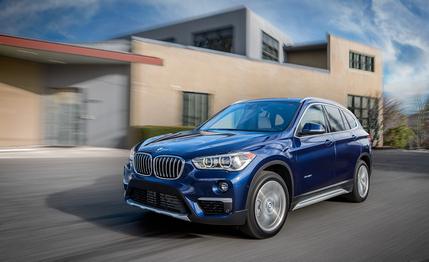
 Instrumented Test
From the March 2016 issue
Instrumented Test
From the March 2016 issue
We warned you this was coming. After a half century spent in the righteous pursuit of driving excellence—rear-wheel drive, spunky four- and six-cylinder engines, near-50:50 weight distributions—BMW clicked its corporate turn signal to veer off in a dastardly direction. The kidney-grilled, Hofmeister-kinked X1 xDrive28i featured here is the first of a troop of front-drive-based BMWs destined for the land of the brave.
Why is this happening? Because U.S. buyers want crossovers—boxy vehicles made out of car parts—and the more the better. In 2015, more than 4 million were sold, and they’re expected to top the combined sales of compact and mid-size sedans this year. Responding, BMW swallowed its sporting pride to feed America’s ravenous crossover appetite.
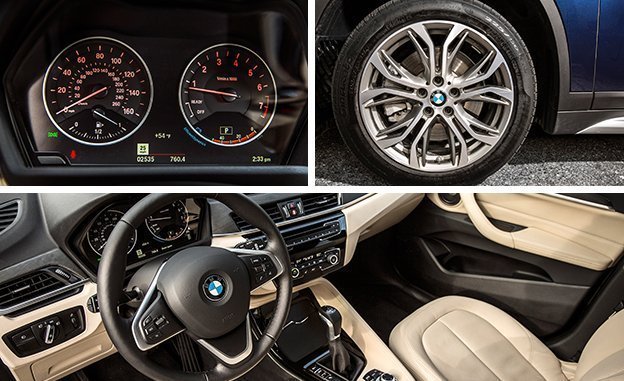

The previous X1 was a wagon in drag; its replacement is tall enough not to be confused with a car. By moving to a front-drive platform [see sidebar below], BMW achieved some notable gains while stomaching inevitable sacrifices.
And yet, this X1 still drives like a car while serving as a truck. BMW has wisely configured it to go toe to toe in the thriving premium compact-crossover category with arch rivals Audi Q3, Lexus NX, and Mercedes-Benz GLA.
Thanks to a front-seat height raised by 1.2 inches, you slide straight into the saddle with no up or down movement. The X1’s interior is beautifully furnished in two shades of French-stitched leather, lovely dark-oak paneling (optional), matte chrome, and piano-black accents. An intelligent mix of knobs and buttons takes the hassle out of adjusting the climate control, making a call, or navigating your way to a restaurant. The 6.5-inch dashtop display screen provides a clear look at both the X1’s soul and the world at large; an 8.8-inch screen is optional. A huge, double-panel sunroof, part of the $3250 Premium package (or $1350 on its own), brightens the interior mood. While the front seats are impressively bolstered and upholstered, they’re a bit too narrow.
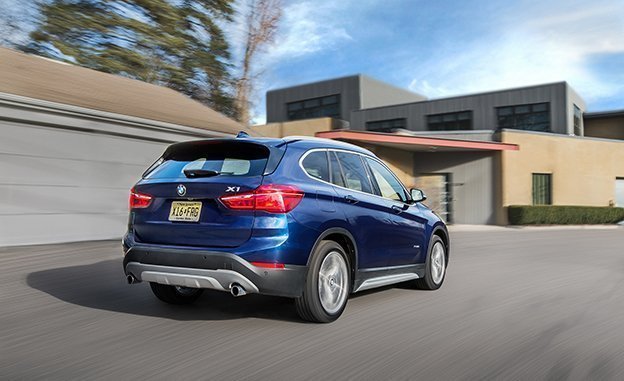
 The X1 doesn't look like heresy. And it doesn't look like a Mini Clubman, either. It looks pretty much like the other BMW SUVs.
The X1 doesn't look like heresy. And it doesn't look like a Mini Clubman, either. It looks pretty much like the other BMW SUVs.
Mostly, though, it’s the rear compartment that surprises and delights. Passengers ride higher than before, with a better view of their surroundings thanks to the X1’s sensible beltline. The more compact powertrain layout also yields 1.5 inches more rear legroom in standard trim, or an additional 2.6 inches with the $300 slide-and-recline seating option.
Behind the seats there’s a 27-cubic-foot cargo hold—up two cubic feet—plus a bonus four cubic feet of stash space under the floor panel. Load height is a handy 28 inches. The power-operated hatch can be opened by swinging a foot under the rear bumper. BMW offers no hitch option, though all X1’s are at least wired to accommodate trailers.
The best news about the X1’s driving dynamics: There’s little hint that the front wheels do most of the work. The steering is quick and keen to respond, though loath to provide any real feedback from the road. The standard M Sport suspension’s ride motions are taut, even in the softest of the three driving dynamic settings, and you feel bumps you can’t even see. Those you do see hurt more.
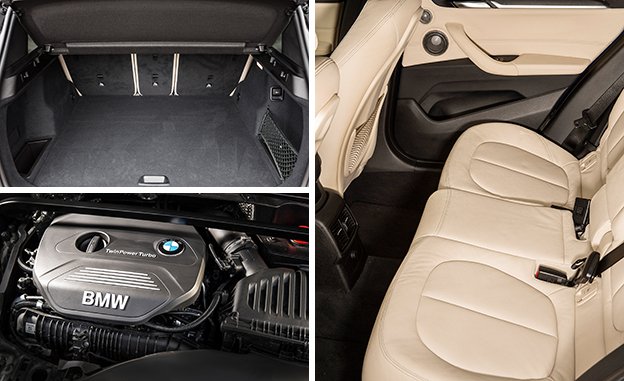

The payoff for this pain is back-road agility, a rare find in crossovers. Rock-and-roll motions are tightly contained, and there are occasional hints of sports-car-wannabe syndrome. That said, when the X1 is pushed past eight-tenths, the truth comes out; the standard 225/50R-18 Pirelli Cinturato P7 All Season tires lack grip, and there’s awkward understeer plus some up-and-down bobbing at the adhesion limit. This rubber is also likely the cause of the longish, 180-feet-from-70-mph stopping distance that we measured. Optional, grippier 19-inch tires are available for $600.
BMW mastered smooth, sweet four-cylinder engines ages ago, and the X1’s new turbocharged 2.0-liter largely lives up to the brand’s elite standards. It collaborates with the new eight-speed wide-ratio Aisin automatic to provide vigorous thrust with no commotion. While the EPA figures—22 mpg city, 32 highway—are unchanged from the old rear-drive model, we saw 25 mpg in this test, a gain of 1 mpg over the 2013 X1 that survived our 40,000-mile enduro.
Unfortunately, peak power drops from 241 to 228 horsepower, yielding slightly slower 60-mph (6.4 seconds) and quarter-mile (14.9 seconds at 94 mph) times, in spite of a curb weight 88 pounds lighter than the outgoing X1. And because the automatic insists on upshifting at 6500 rpm, even in manual mode, the 7100-rpm redline is window dressing. While the console shifter is entirely adequate, those longing for shift paddles can get them by adding the $2450 M Sport package. Those longing for a manual can go pound sand; one is not available.
Overall, we have mixed feelings about BMW’s migration in the front-drive direction. Even though the new X1 will surely excel as a competitive luxury crossover, we don’t see it as one of the brighter stars in BMW’s firmament.
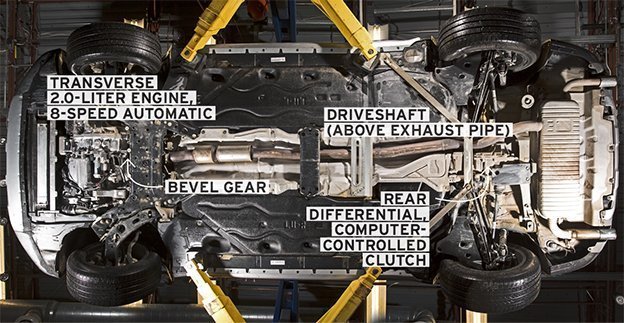

The BMW Group has engineered front-drive Mini Coopers since 2001 as the opening act for the subversive X1. Its new UKL2 platform, shared with the Mini Cooper Clubman and the BMW 2-series Active Tourer (not destined for sale here), has a classic, tightly packed transverse-powertrain layout that will underpin many future BMWs and Minis.
Mounting the engine crossways not only saves space, it also cuts frictional losses by a few percent since the crankshaft and the front axle rotate on parallel axes. Three- and four-cylinder gas and diesel powerplants are part of this strategy. While a simple on-demand four-wheel-drive system is standard in the X1, a less expensive front-drive edition is also expected. The driveshaft and two bevel gears necessary to power the rear wheels naturally increase driveline friction.
The eight-speed Aisin automatic spins both the front wheels and the longitudinal driveshaft. An electronically controlled clutch pack built into the rear differential engages the back wheels when desired. This is a slippery-road traction device, not a scheme to vector torque for more-agile handling.
A simple suspension system—struts in front, trailing arms located by upper and lower lateral links in back, four coil springs—saves weight, cost, and space.
The bottom line is a more efficient shipping container.
Versus the outgoing X1 hatch, the new crossover is 1.7 inches taller, 0.9 inch wider, 1.1 inches shorter, and 88 pounds lighter. The wheelbase was shortened 3.6 inches to a tidy 105.1 inches. Functional gains include a more useful back seat and two additional cubic feet of cargo space.